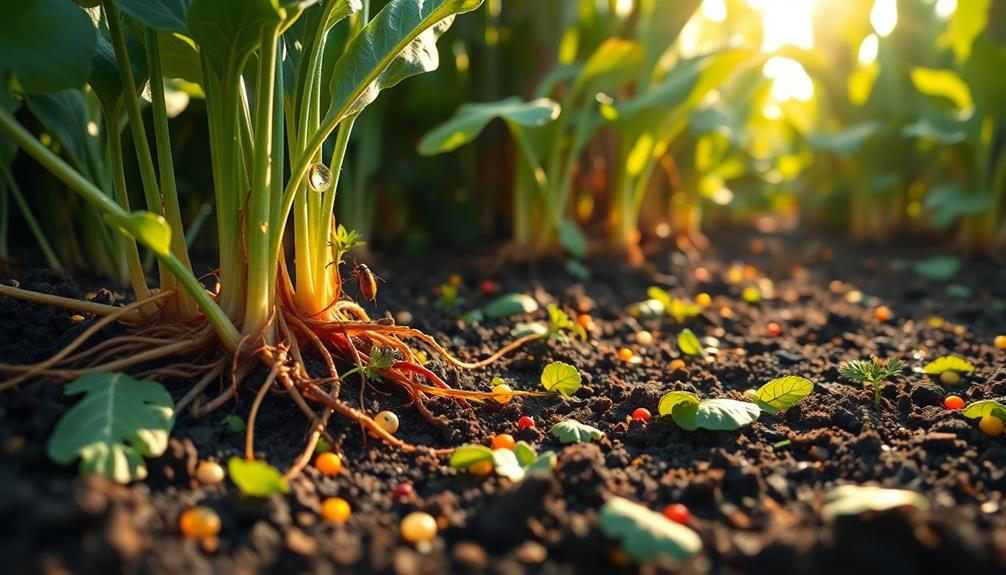Soil microbiomes surprisingly shape the flavors of your crops by influencing nutrient absorption and the synthesis of flavor compounds. Diverse microorganisms improve nutrient availability, which directly affects taste quality. For instance, specific microbes boost glucosinolates, enhancing spiciness in crops like mustard. Healthy soils with rich organic matter lead to more vibrant flavors as these microbes interact with roots to support plant health. Additionally, crucial minerals in the soil, such as selenium and zinc, play a crucial role in flavor development. Discovering the intricate links between soil health and crop flavor can reveal even more fascinating insights.
Key Takeaways
- Soil microbiomes enhance the synthesis of flavor compounds by modulating biochemical pathways, particularly increasing glucosinolates in crops like mustard and Brassica.
- Microbial diversity in the soil directly influences the chemical composition of crops, resulting in variations in flavor intensity and quality.
- Nutrient-rich soils, supported by healthy microbial communities, improve crop absorption of essential minerals, which significantly enhance flavor profiles.
- Specific soil microbes can alter root-microbe interactions, stimulating the production of phytohormones that contribute to flavor compound synthesis in plants.
- Soil amendments and microbial probiotics can boost phytochemical concentrations, further enhancing flavor characteristics in various crops.
Understanding Soil Microbiomes
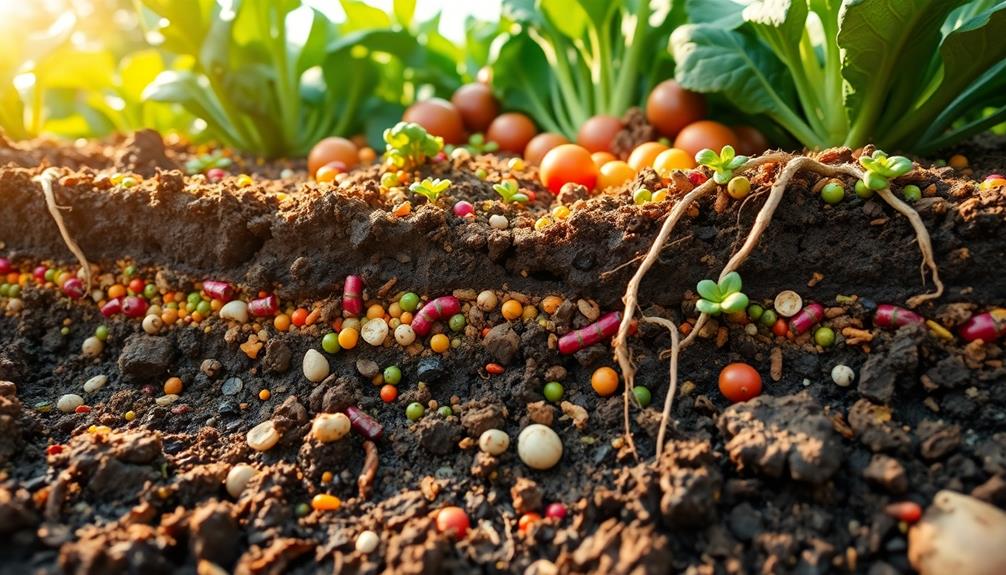
Soil microbiomes, teeming with diverse microorganisms like bacteria and fungi, play an indispensable role in nutrient cycling and plant growth. These microbial communities are essential for breaking down organic matter, making nutrients available for plants, and fostering healthy soil ecosystems.
When you cultivate crops, you're not just nurturing the plants; you're also supporting these important microorganisms that help shape your harvest.
The interactions between soil microbiomes and crops can be as rich and diverse as Brazilian cuisine, where various cultural influences create unique flavors traditional dishes. Understanding soil microbiomes helps you recognize their impact on plant health and flavor.
For example, specific microbes can enhance nutrient availability, influencing secondary metabolites in plants, which contribute to taste and aroma. In crops like mustard, certain bacteria boost glucosinolate levels, intensifying spiciness and unique flavor profiles.
Changes in environmental conditions or amendments can alter these microbial communities, leading to variations in chemical profiles that affect both flavor and nutritional value.
Role of Microbes in Flavor Development
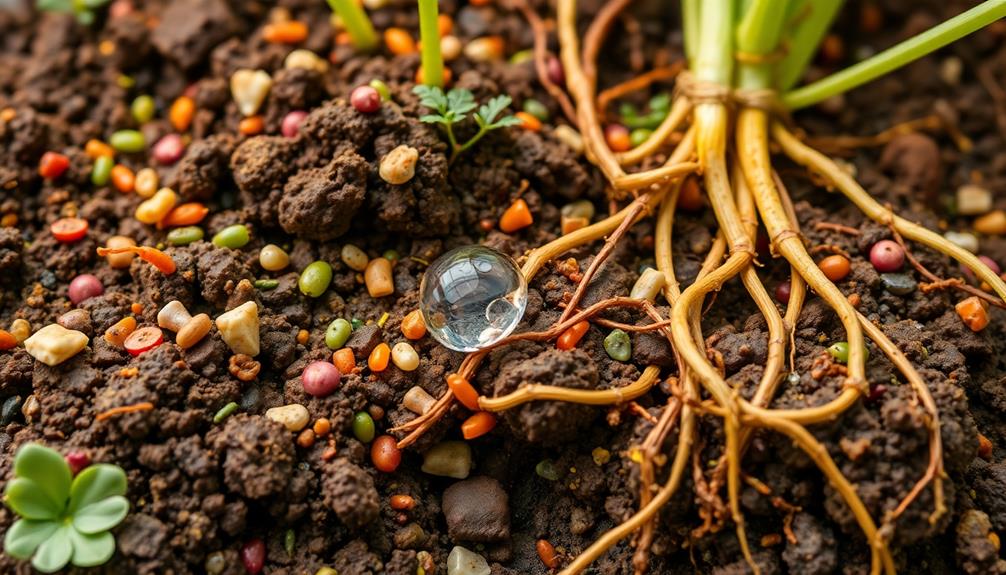
Microbes play a vital role in shaping the flavors of the crops you grow. The soil microbiome markedly influences the concentration of plant secondary metabolites, like glucosinolates, which are fundamental for the distinct taste and aroma of crops such as mustard and other Brassica family vegetables.
Specific soil microbes can enhance the spiciness of mustard seeds by affecting the biochemical pathways involved in glucosinolate production. This connection links soil health to flavor profiles, highlighting the importance of a diverse microbial community. Notably, just as the rich flavors of Red-Braised Pork Belly benefit from careful ingredient combinations, the flavors of crops can be greatly enhanced by the right microbial interactions.
When soil microbes interact with plant roots, they not only improve nutrient uptake but also impact the synthesis of flavor compounds, directly affecting crop taste quality. Research shows that variations in microbial diversity can lead to differences in the chemical composition of crops, resulting in changes in flavor intensity and nutritional value.
Additionally, preliminary evidence suggests that applying microbial probiotics to your soil might enhance desirable flavor characteristics in your crops. This could improve marketability and align with consumer preferences for flavorful vegetables, making the role of microbes in flavor development essential for both taste and agricultural success.
Nutrient Uptake and Crop Quality
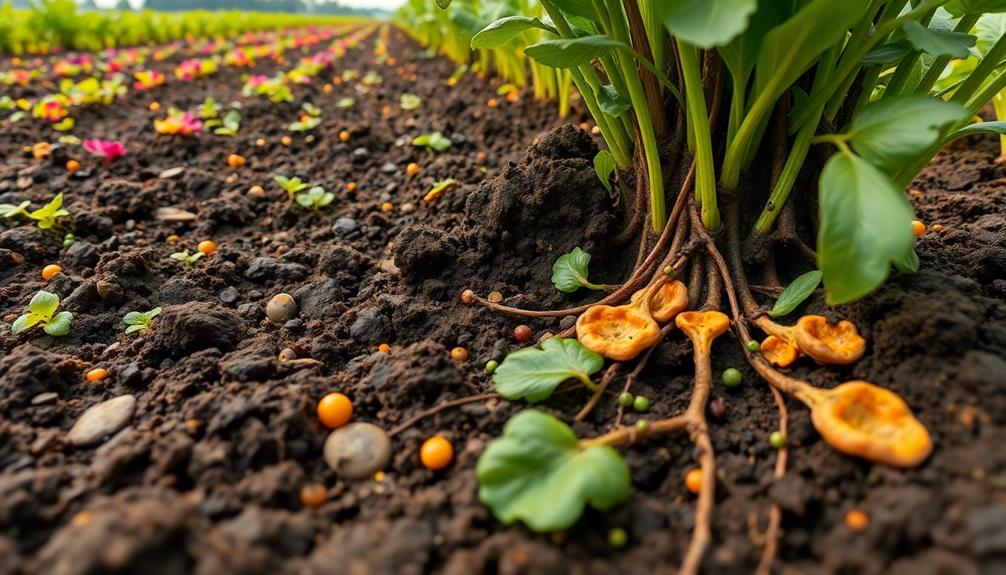
The nutrient composition of your soil directly affects how well your crops absorb essential minerals, which in turn influences their taste and quality.
For instance, crops like heirloom beans can showcase enhanced flavors when grown in nutrient-rich soil, highlighting the importance of soil health in celebrating culinary traditions.
When you maintain a healthy balance of nutrients, like selenium and zinc, you can enhance the flavor profiles of your fruits and vegetables.
Plus, the right soil microbes play a vital role in improving nutrient uptake, leading to tastier and more robust crops.
Soil Nutrient Composition
Nutrient composition in the ground plays an essential role in determining the flavors of the crops you grow. The levels of essential soil nutrients like selenium, zinc, and magnesium greatly impact the taste and nutritional value of your produce. When plants absorb these nutrients, they directly influence the chemical compounds that contribute to flavor and aroma.
Soil pH and organic matter content also affect nutrient uptake, shaping the overall quality of the crops you produce. Rich organic soil is linked to stronger, more robust flavors, emphasizing the need to maintain soil health for ideal crop production. Specific nutrients, especially nitrogen, are pivotal in synthesizing flavor compounds, helping develop the desirable taste attributes in fruits and vegetables.
Additionally, the soil microbiome plays an important role in nutrient cycling, ensuring the availability of these key nutrients. A healthy microbial community can enhance nutrient uptake, ultimately improving the flavor and quality of your crops.
Microbial Influence on Flavors
Understanding soil nutrient composition lays the groundwork for exploring how microbial communities influence crop flavors.
The soil microbiome plays an essential role in nutrient uptake, directly impacting the quality and taste of your crops. By fostering diverse microbial life, you can enhance the production of plant metabolites, which are vital for flavor development.
Here are some ways microbial influence can shape crop flavors:
- Improved Nutrient Absorption: Microbial communities help plants access essential nutrients and water more effectively.
- Flavor Compound Production: Specific minerals like selenium, zinc, and magnesium can boost the flavor profiles of your crops.
- Enhanced Glucosinolates: Research shows that diverse soil microbiomes increase glucosinolates, adding spiciness to Brassica family crops like mustard.
- Microbial Inoculants: Applying these can shift microbial dynamics, resulting in higher concentrations of beneficial plant metabolites.
Impact of Soil Health on Taste
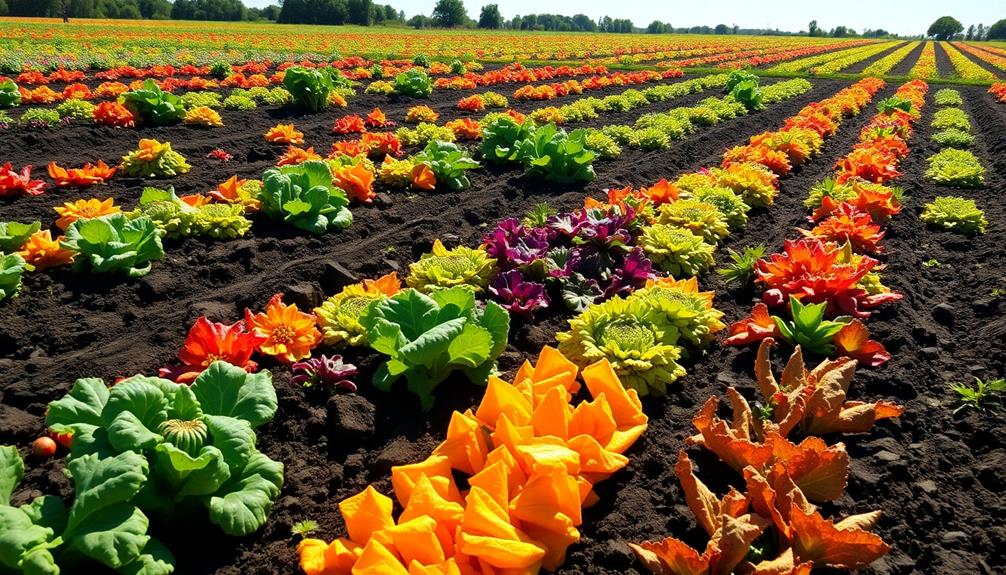
Soil health plays an essential role in determining the taste of your crops.
When you guarantee rich, diverse soils with the right minerals and microorganisms, you'll likely notice more vibrant flavors in your fruits and vegetables.
Understanding how soil composition directly influences flavor can help you grow tastier produce.
Microbial Influence on Flavor
The intricate relationship between microbial communities in the ground and the flavors of the crops you enjoy is fascinating.
These soil microbial communities directly influence the taste profiles of your favorite fruits and vegetables by affecting nutrient absorption and promoting the production of flavor compounds.
Here's how they work their magic:
- Organic matter: Rich organic soils foster healthier microbial life, leading to stronger, more robust flavors.
- Flavor compounds: Microbes can alter biochemical pathways in plants, enhancing compounds like glucosinolates, which contribute to unique tastes.
- Mineral content: Specific minerals, such as selenium, zinc, and magnesium, enhance flavors, proving that the right soil composition matters.
- Diversity in microbes: Unique microbial inoculums can impact the spiciness of crops, as seen in mustard seeds, showcasing the connection between soil health and flavor chemistry.
Maintaining a healthy soil microbiome is essential for ideal nutrient absorption, which in turn affects the levels of flavor compounds in your crops.
Soil Composition and Taste
Microbial communities play a pivotal role in shaping how we experience flavors, but their influence doesn't stop there. The composition of soil is essential in determining the taste of the crops you enjoy. Variations in mineral content, pH levels, and moisture directly affect how plants absorb taste-related compounds. For instance, nutrient-rich soils—those loaded with minerals like selenium, zinc, and magnesium—can enhance the intensity and quality of flavors in vegetables and fruits.
Healthy soil ecosystems, characterized by diverse microbial life, are critical for robust plant growth. These microorganisms facilitate improved nutrient uptake, leading to stronger flavors. A rich organic soil, filled with organic matter, lays the groundwork for healthier microbial populations, which in turn support flavorful compound production in crops.
Additionally, the health of the soil directly impacts the concentration of glucosinolates in plants from the Brassica family, like mustard and broccoli. These compounds contribute to the characteristic spicy and bitter notes that many love.
Microbial Diversity and Crop Variability

A rich diversity of microbes in the soil greatly shapes the flavor profiles of crops you might grow. This microbial diversity influences the synthesis of flavor compounds, which are essential to how your plants taste.
Variability in soil composition, including nutrient levels and organic matter, directly affects which microbial populations thrive, thereby impacting crop performance and flavor quality.
Here are some key points to bear in mind:
- Specific soil microbes can enhance glucosinolates in Brassica crops, adding spicy and bitter notes.
- Diverse microbial inoculants can increase flavor intensity in crops like mustard.
- The interaction between soil microbes and plant roots alters biochemical pathways responsible for flavor development.
- Maintaining a healthy and varied soil microbiome is vital for ideal flavor quality.
The Connection Between Soil and Aroma
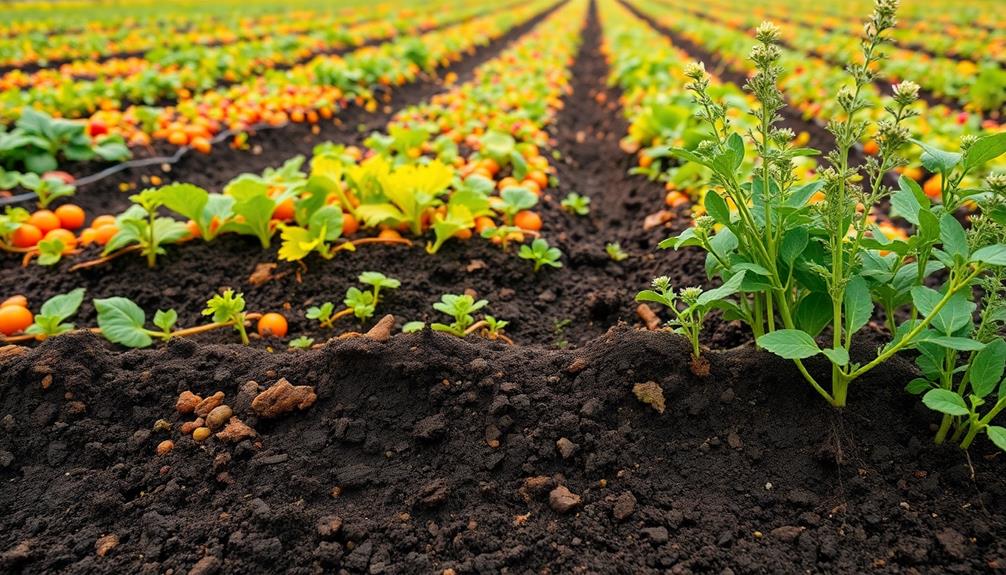
Flavor isn't just about taste; aroma plays an equally essential role in how you experience your food. The connection between soil and aroma is profound, as the characteristics of the soil directly influence the flavor profiles of food crops.
Healthy soil, rich in organic matter and minerals like selenium, zinc, and magnesium, enhances nutrient absorption, leading to the production of aromatic compounds in plants.
The microbial community within the soil is vital here. These microbes help determine the chemical composition of crops, influencing the biosynthesis of flavor-related compounds. For example, in Brassica species, soil microbes can greatly impact the production of glucosinolates, which contribute to their distinctive aroma and taste.
Research shows that crops grown in rich organic soils tend to exhibit stronger, more robust flavors. This indicates that a thriving soil microbiome can lead to enhanced food flavor, making your meals more enjoyable.
Additionally, manipulating soil microbiomes through microbial inoculants presents an exciting opportunity to improve flavor intensity, ultimately giving you more flavorful produce.
Soil Amendments and Flavor Enhancement
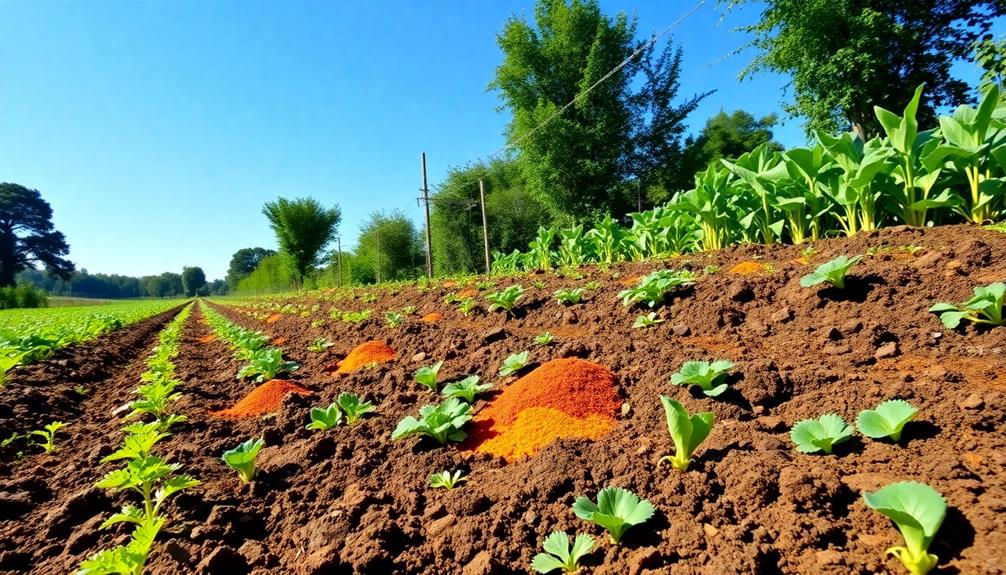
Soil amendments can greatly boost the flavor profiles of your crops, transforming the way you experience your food. By introducing the right soil amendments, you can enhance the microbial community in your garden, which plays a vital role in flavor enhancement.
Here are some effective amendments to take into account:
- Microbial probiotics: These can increase phytochemical concentrations, like glucosinolates in mustard plants.
- Organic sludges: Adding these can improve microbial diversity, correlating with better flavor characteristics in fruits and vegetables.
- Essential minerals: Nutrients such as selenium, zinc, and magnesium can greatly enhance crop flavors.
- Compost: This can modulate existing microbial communities, leading to improved taste and nutritional value in crops like strawberries.
When you focus on your soil's composition and utilize the right amendments, you not only boost crop productivity but also elevate the taste experience of your harvest.
Research shows that these changes in the microbial community can directly impact nutrient uptake, influencing the aroma and flavor of the food you grow.
Embrace soil amendments, and you'll be delighted by the flavors that await your palate!
Microbial Interactions With Plant Roots

When you consider the relationship between plants and their root microbiomes, you can see how microbial diversity plays an essential role in flavor compound synthesis.
These microorganisms enhance nutrient uptake mechanisms, which not only supports plant health but also influences the taste of the crops you enjoy.
Understanding these interactions can give you insights into how soil health directly affects food flavor.
Root Microbiome Diversity
Exploring the root microbiome reveals a complex world of microbial interactions that greatly influence plant health and flavor. The diversity of microorganisms associated with plant roots plays a pivotal role in shaping the chemical composition of flavor compounds.
When you consider the following aspects, you'll appreciate just how critical this diversity is:
- Root growth: A rich microbial community can enhance root development, leading to healthier plants.
- Soil management: Practices that promote microbial diversity can optimize nutrient availability and uptake.
- Microbial diversity: Higher diversity often correlates with more intense and complex flavors in crops.
- Flavor compounds: Specific interactions, like those between rhizobacteria and plant roots, can boost the production of flavor-related metabolites.
Flavor Compound Synthesis
The interactions between soil microbiomes and plant roots greatly influence the synthesis of flavor compounds in crops. Beneficial microbial communities, particularly plant growth-promoting rhizobacteria (PGPR), play an essential role in enhancing flavor by stimulating the production of phytohormones and secondary metabolites.
For instance, in plants from the Brassica family, such as mustard, specific microbes can increase the production of glucosinolates, which contribute to their distinct spicy and bitter flavors.
Research indicates that the presence of diverse microbial inoculants can markedly alter the flavor profile of crops, demonstrating a direct correlation between microbial diversity and flavor compound synthesis.
Additionally, certain soil minerals like selenium and zinc, facilitated by these microbial communities, enhance the biosynthesis of flavor compounds.
The complexity of soil microbiomes means that flavor compound synthesis can evolve over time. As microbial communities change throughout the growing season, so can the chemistry and flavor of your crops.
Nutrient Uptake Mechanisms
Enhancing nutrient uptake, soil microbes play an essential role in plant health and flavor development. By interacting with plant roots, these microorganisms create favorable conditions for nutrient absorption, which is vital for producing rich flavor compounds in crops.
Here's how soil microbes enhance nutrient uptake:
- Phytohormone Production: They stimulate root growth, increasing surface area for better nutrient absorption.
- Mycorrhizal Partnerships: Fungi form symbiotic relationships with roots, greatly boosting the absorption of essential nutrients like phosphorus and nitrogen.
- Drought Tolerance: Beneficial rhizobacteria, such as Paenibacillus polymyxa, regulate gene expression to enhance both water and nutrient uptake, improving plant resilience.
- Siderophore Secretion: Certain microbes bind to iron in the soil, facilitating its uptake by plants, which can enhance growth and flavor profiles.
These interactions not only support effective nutrient uptake but can also alter metabolic processes in plants.
The result? Changes in the concentrations of flavor compounds, like glucosinolates in mustard plants.
Case Studies in Flavor Variation
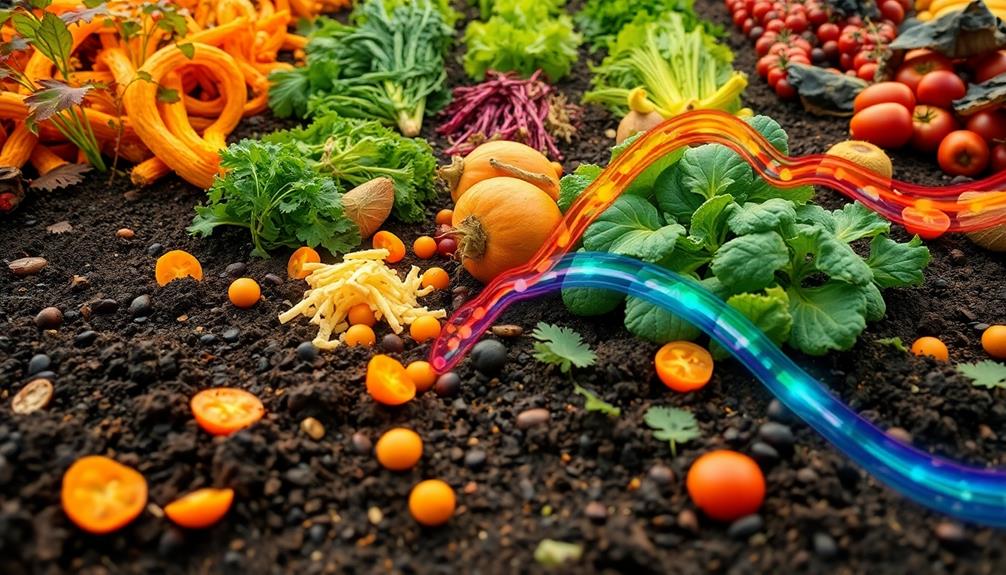
While investigating the intricate relationship between soil microbiomes and crop flavors, researchers have uncovered compelling case studies that showcase significant variations in taste. One standout experiment focused on mustard plants, where different microbial communities dramatically altered flavor profiles. Mustard inoculated with microbes from aspen groves exhibited a spicier taste, thanks to higher glucosinolate concentrations, while those from agricultural pastures produced milder flavors.
The following table illustrates these intriguing findings:
| Microbial Source | Flavor Profile |
|---|---|
| Aspen Groves | Spicy |
| Agricultural Pastures | Mild |
| Diverse Microbial Mix | Varies |
| Control Group | Neutral |
These variations underline the importance of soil microbiomes not just for plant health but also for the sensory attributes of crops. As the study progressed, researchers encountered challenges with evolving microbiomes, highlighting the complexity of microbial interactions. Preliminary evidence even suggests that specific soil microbes could enhance spiciness, hinting at the potential for microbial probiotics to improve crop flavor attributes. This research truly emphasizes the nuanced role of microbial diversity in shaping our food experiences.
Future Research Directions in Flavor Science
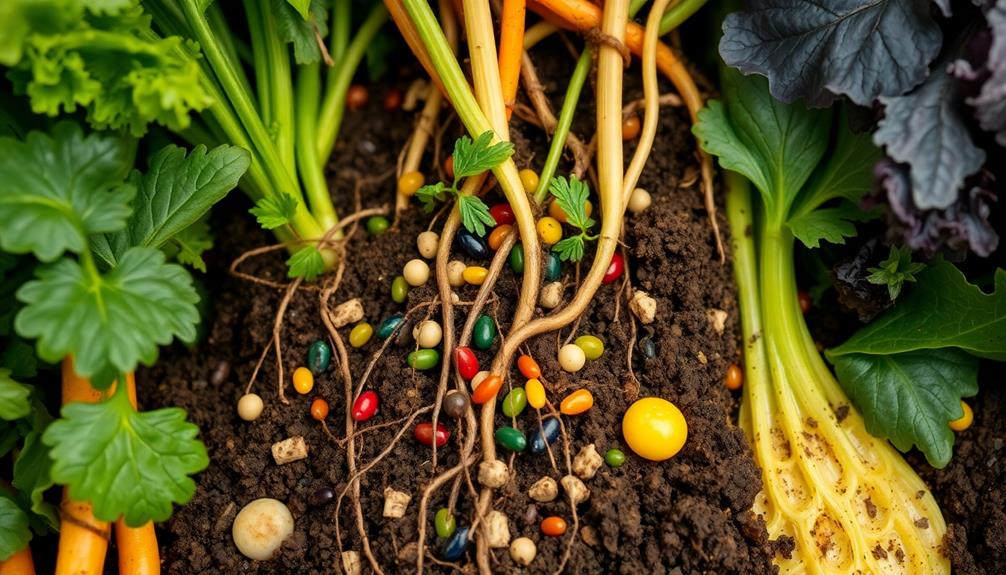
Research into the relationship between soil microbiomes and crop flavors has opened up exciting avenues for future investigation. As you immerse yourself in this field, contemplate exploring the intricate dynamics between specific soil microbial communities and the flavor profiles of various crops.
Here are some key research directions to ponder:
- Microbial Diversity: Investigate how different microbial populations can enhance flavor compounds, such as glucosinolates in Brassica species.
- Soil Amendments: Study the effects of various soil amendments on microbial communities and their subsequent impact on crop flavor and nutritional quality.
- Plant Metabolism Mechanisms: Understand how soil microbes influence plant metabolism, particularly in synthesizing volatile compounds that contribute to flavor.
- Abiotic Factors: Examine how soil composition and moisture levels mediate interactions between soil microbiomes and crop flavors.
Collaborative efforts between flavor scientists and soil microbiologists could yield innovative strategies for developing microbial inoculants aimed at enhancing crop flavor characteristics.
Frequently Asked Questions
What Are the Factors Affecting Soil Microbiome?
Soil microbiome factors include composition, mineral content, organic matter, pH, moisture, and seasonal temperature changes. Agricultural practices, like chemical use, also disrupt microbial balance, affecting diversity and functionality in your soil's ecosystem.
How Do Soil Microbes Affect Plants?
Imagine vibrant plants thriving, their roots entwined with lively soil microbes. These tiny allies boost nutrient uptake, enhance growth, and transform your garden into a flavorful paradise, where every bite bursts with nature's rich essence and energy.
What Is a Modern Problem That Can Affect Soil Microbiota?
A modern problem affecting soil microbiota is intensive farming. It disrupts microbial balance, leading to reduced diversity. You'll notice this imbalance impacts nutrient cycling, harming plant health and ultimately reducing crop yields and resilience.
How Does the Microbiome Affect Plant Growth?
You might think plants grow on their own, but surprise! Their microbiome's busy working hard, boosting nutrient uptake and root growth. So, next time you admire your garden, thank those tiny microbes for the show!
Conclusion
In summary, the fascinating world of soil microbiomes plays a vital role in shaping the flavors of our favorite crops. Did you know that studies show crops grown in diverse microbial environments can have up to 30% more flavor compounds? By nurturing soil health and microbial diversity, you're not just enhancing crop quality but also enriching your culinary experiences. As we continue to explore this connection, the future of flavor science looks incredibly promising.
